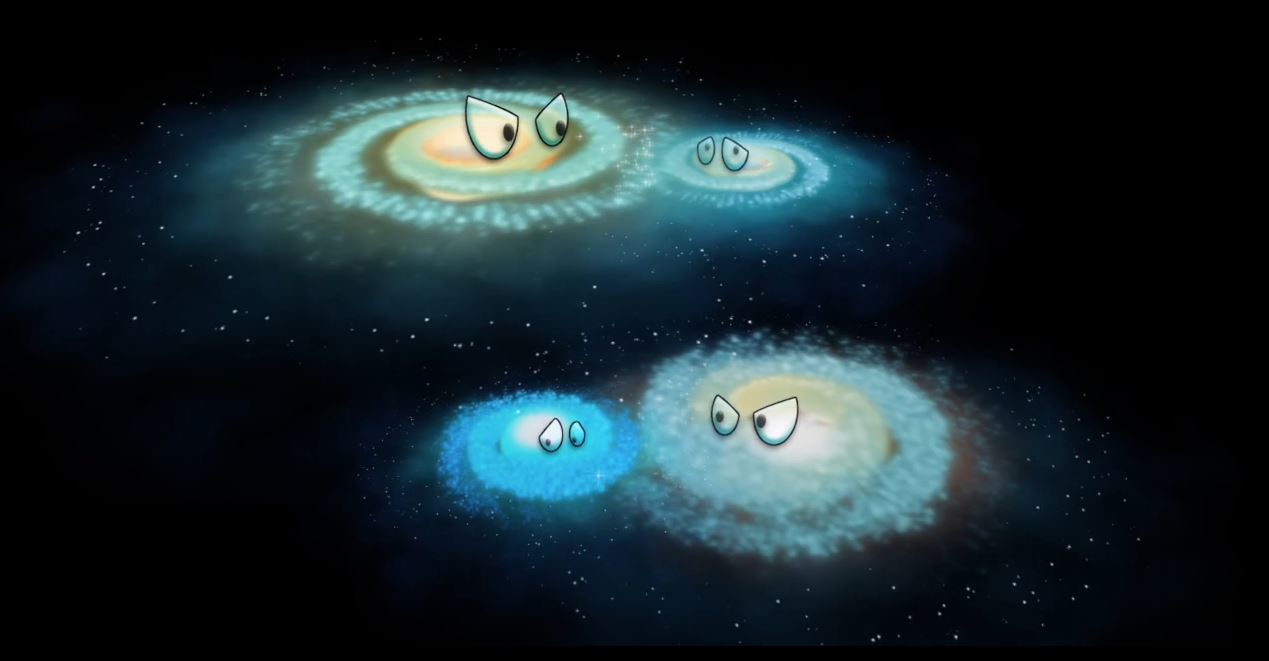Cosmic Giant Takes on Galactic Dwarf in Adorable Video

What happens when a cosmic bully collides with a galactic dwarf? The big guy comes out on top, according to a new study.
Sometimes size does matter: In a survey of more than 20,000 merged galaxies, researchers found that star formation sped up in the larger of two galaxies, but nearly came to a halt in the smaller one. When the two galaxies are of roughly equal mass, they both see an increase in star formation. You can watch an adorable video explaining the new results here on Space.com.
The cause of this unbalanced outcome may be due to the larger galaxy slurping up the smaller galaxy's supply of gas, from which new stars form.
When two galaxies collide, astronomers suspect that clouds of gas inside the galaxy get churned up and seed new star birth faster than if the two galaxies remained separate, and tranquil. But as the new study shows, this isn't the case for smaller galaxies.
"This might be because the bigger galaxy strips away its smaller companion's gas, leaving it without star-forming fuel or because it stops the smaller galaxy obtaining the new gas required to form more stars," said Luke Davies, of the International Centre for Radio Astronomy Research (ICRAR) at the University of Western Australia, and author of the new research.
The findings may one day have big implications for star formation in the Milky Way galaxy, which is on a collision course with the nearby Andromeda galaxy. The two neighbors are moving toward each other at 248,548 mph (400,000 kilometers per hour).
"Don't panic yet, the two won't smash into each other for another four billion years or so," Davies said in a statement.
Get the Space.com Newsletter
Breaking space news, the latest updates on rocket launches, skywatching events and more!
The two relatively large galaxies ("cosmic tanks," he calls them) are of a similar mass, so it's more likely that the collision will spur star formation in both of them.
"Investigating such cosmic collisions lets us better understand how galaxies grow and evolve," Davies said.
The new research employed the Galaxy and Mass Assembly (GAMA) survey using the Anglo-Australian Telescope in New South Wales, and was published online on July 12 in the journal Monthly Notices of the Royal Astronomical Society.
Follow Calla Cofield @callacofield.Follow us @Spacedotcom, Facebook and Google+. Original article on Space.com.
Join our Space Forums to keep talking space on the latest missions, night sky and more! And if you have a news tip, correction or comment, let us know at: community@space.com.

Calla Cofield joined Space.com's crew in October 2014. She enjoys writing about black holes, exploding stars, ripples in space-time, science in comic books, and all the mysteries of the cosmos. Prior to joining Space.com Calla worked as a freelance writer, with her work appearing in APS News, Symmetry magazine, Scientific American, Nature News, Physics World, and others. From 2010 to 2014 she was a producer for The Physics Central Podcast. Previously, Calla worked at the American Museum of Natural History in New York City (hands down the best office building ever) and SLAC National Accelerator Laboratory in California. Calla studied physics at the University of Massachusetts, Amherst and is originally from Sandy, Utah. In 2018, Calla left Space.com to join NASA's Jet Propulsion Laboratory media team where she oversees astronomy, physics, exoplanets and the Cold Atom Lab mission. She has been underground at three of the largest particle accelerators in the world and would really like to know what the heck dark matter is. Contact Calla via: E-Mail – Twitter









